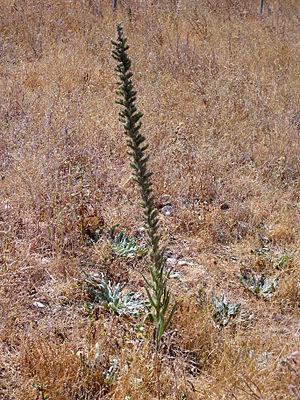Echium boissieri
| Echium boissieri | ||||||||||||
|---|---|---|---|---|---|---|---|---|---|---|---|---|

Echium boissieri |
||||||||||||
| Systematics | ||||||||||||
|
||||||||||||
| Scientific name | ||||||||||||
| Echium boissieri | ||||||||||||
| Steud. |
Echium boissieri is a plant from the genus of snake heads ( echium ) in the family of the Boraginaceae (Boraginaceae).
description
Echium boissieri is a bristly hairy, erect, biennial to perennial plant that reaches heights of 60 to 250 cm. It forms a single or a dominant flower-bearing stem . The two-layer, dense hair on the stem consists of protruding, whitish bristles and short hairs. The basal leaves are 100 to 250 mm long and 40 to 50 mm wide. Their shape is elliptical to lanceolate, they are hairy with close-fitting, soft bristles. The stem leaves are narrowly elliptical to lanceolate and 70 to 150 mm long and 10 to 20 mm wide.
The entire inflorescence is spike-like with short coils . The densely white-bristled calyx is 8 to 9 mm long. It hardly extends when the fruit is ripe. The crown is 16 to 18 mm long, very narrow, funnel-shaped, colored flesh pink and finely haired, especially on the crown tips. Five stamens protrude from the crown, the stamens are red. The triangular Klausen are 3 to 3.5 mm long and irregular, with bumps covered.
The flowering period extends from May to July (less often to August).
The number of chromosomes is 2n = 10.
Occurrence
The species occurs on the central and southern Iberian Peninsula as well as in Morocco and Algeria.
It grows preferentially on nitrogen-rich and loamy soils and colonizes ruderal locations such as roadsides and ditches, stony fallow land and embankments. They are found in Spain and Portugal at an altitude between 300 and 1300 m. The species, which originally only occurs in Andalusia in Spain, is spreading along the traffic routes.
Taxonomy
Echium boissieri was first published in 1840 by Ernst Gottlieb von Steudel and replaces the invalid homonyms Echium lagascae Boiss. (1838) non Roman. & Schult. (1819) and probably Echium albicans Schott (1819) non Lag. & Rodr. (1802). A somewhat more recent synonym is Echium pomponium Boiss. (1841).
swell
literature
- PE Gibbs: Echium . In: TG Tutin, VH Heywood, NA Burges, DM Moore, DH Valentine, SM Walters, DA Webb (eds.): Flora Europaea . Volume 3: Diapensiaceae to Myoporaceae . Cambridge University Press, Cambridge 1972, ISBN 0-521-08489-X , pp. 99 (English, limited preview in Google Book Search).
Individual evidence
- ^ A b Jonas V. Müller, Ulrich Deil, Antonio Galán de Mera, José Alfredo Vicente Orellana: Echium boissieri Steud. (Boraginaceae), on Ibero-Mauretanian roadside plant. In: Fedde's repertory. Volume 116, No. 3-4, 2005, pp. 226-242, doi: 10.1002 / fedr.200511071 .
- ↑ a b c d e f g h PE Gibbs: Taxonomic studies on the genus Echium. 1. An outline revision of the Spanish species. In: Lagascalia. Volume 1, pp. 27-82 ( Echium boissieri on pp. 39-42), PDF .
- ↑ a b c d Benito Valdés: Echium L. In: Santiago Castroviejo, C. Andrés, M. Arista, MP Fernández Piedra, MJ Gallego, PL Ortiz, C. Romero Zarco, FJ Salgueiro, S. Silvestre, Alejandro Quintanar (eds .): Flora Ibérica. Plantas Vasculares de la Península Ibérica e Islas Baleares. Vol. XI. Gentianaceae - Boraginaceae . Real Jardín Botánico, CSIC, Madrid 2012, ISBN 978-84-00-09415-7 , p. 442 ( floraiberica.es [PDF]).
- Jump up ↑ a b Ernst Gottlieb von Steudel: Nomenclator botanicus, seu, Synonymia plantarum universalis: enumerans ordine alphabetico nomina atque synonyma, tum generica tum specifica, et a Linnaeo et a recentioribus de re botanica scriptoribus plantis phanerogamis imposita. 2nd Edition. Volume 1, Cotta, Stuttgart / Tübingen 1840, digitized .